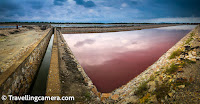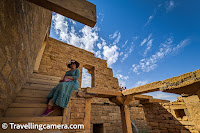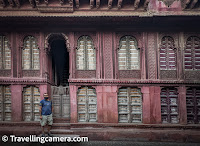The Hawa Mahal, also known as the Palace of Winds, is one of Jaipur's most recognizable landmarks and a masterpiece of Rajput architecture. Built in 1799 by Maharaja Sawai Pratap Singh, this stunning palace was designed to allow royal ladies to observe daily life and festivities on the street without being seen themselves, adhering to the strict purdah system. With its intricate latticework and honeycomb-like structure, Hawa Mahal stands as a symbol of Jaipur’s royal past and architectural grandeur.
Historical Significance
The construction of Hawa Mahal was inspired by the shape of Lord Krishna's crown, symbolizing the Maharaja's devotion to the Hindu deity. Maharaja Sawai Pratap Singh commissioned this structure as an extension of the City Palace, primarily to provide a private viewing gallery for the royal women. This architectural marvel served as a vantage point from which the ladies of the royal family could watch the lively processions, markets, and celebrations on the streets of Johari Bazaar below.
Architectural Design
The Hawa Mahal is built in the Rajput architectural style, blended with elements of Mughal design. Its unique façade is often compared to a beehive, featuring 953 small windows, known as jharokhas, adorned with intricate latticework. The palace’s design ensures a natural flow of air throughout the structure, keeping it cool even during the scorching summers, which gave it the name "Hawa Mahal" (Palace of Winds).
Key Architectural Features:
Five-Story Structure: The palace rises five stories high, with each level intricately decorated. The top three stories are narrow, resembling a terrace or balcony, while the lower two floors are more spacious, with courtyards and galleries.
Pyramidal Shape: The Hawa Mahal’s façade is built in a pyramidal shape that gradually narrows as it ascends. This design gives the palace a towering appearance while maintaining its elegant proportions.
Red and Pink Sandstone: The palace is constructed from red and pink sandstone, which not only adds to its aesthetic appeal but also blends seamlessly with the architectural style of Jaipur, known as the Pink City.
Latticework (Jaalis): The intricate latticework on the jharokhas serves a dual purpose. It allowed the royal women to observe the bustling city life without being seen and also facilitated the circulation of cool breezes through the palace.
Courtyards and Inner Chambers: Inside the palace, there are several courtyards, passages, and beautifully decorated chambers that lead up to the top floors. The interior design is simpler compared to the elaborate exterior but reflects the essence of Rajasthani art and culture.
Purpose of the Palace
The primary purpose of Hawa Mahal was to provide a discreet observational point for the women of the royal household. In adherence to the purdah system, which restricted women from appearing in public or mingling with strangers, the jharokhas allowed them to enjoy street festivals, watch parades, and observe the daily activities in the bazaar below without compromising their privacy.
Legends and Stories Associated with Hawa Mahal
There are several legends associated with the construction of Hawa Mahal. It is said that Maharaja Sawai Pratap Singh was so enchanted by the architecture of Khetri Mahal in Jhunjhunu that he wanted a similar structure in Jaipur. He directed his chief architect, Lal Chand Ustad, to design a palace that would serve as a tribute to the Rajput women’s tradition and their lifestyle.
Cultural and Historical Importance
Hawa Mahal has stood the test of time as a cultural icon of Jaipur, not only for its architectural beauty but also for its symbolic representation of the Rajput heritage. It represents the royal family’s dedication to preserving the customs and traditions of that era while incorporating Mughal influences into their architectural practices.
The palace is now a popular tourist attraction, symbolizing the rich history and culture of Rajasthan. It is a part of the City Palace complex, and its connection to the palace highlights its importance in the daily lives of the royal family.
Visiting Hawa Mahal
Today, Hawa Mahal is a prominent tourist destination in Jaipur, attracting visitors from around the world who come to marvel at its exquisite design and historical significance. The palace also offers a stunning view of the City Palace, the Jantar Mantar, and the bustling Sireh Deori Bazaar from its upper floors.
Practical Information for Visitors:
Location: Hawa Mahal is situated in the heart of Jaipur, on Hawa Mahal Road, near the bustling Johari Bazaar.
Opening Hours: The palace is open daily from 9:00 AM to 5:00 PM.
Entry Fees: There is a nominal entry fee for both Indian and international visitors, with different charges for photography.
Best Time to Visit: The best time to visit Hawa Mahal is during the cooler months, from October to March, when the weather is pleasant. Early mornings are ideal for capturing beautiful photographs of the palace in the soft sunlight.
Nearby Attractions
While visiting Hawa Mahal, you can explore several other nearby attractions:
City Palace: Located just a short walk from Hawa Mahal, the City Palace is a majestic complex that houses a museum showcasing royal artifacts.
Jantar Mantar: An 18th-century astronomical observatory recognized as a UNESCO World Heritage site.
Johari Bazaar: One of Jaipur’s oldest markets, famous for its jewelry, textiles, and traditional handicrafts.
Conservation and Restoration Efforts
Over the years, several restoration efforts have been undertaken to preserve the Hawa Mahal’s structure and intricate designs. The Archaeological Survey of India (ASI), along with other heritage conservation groups, has played a significant role in maintaining the palace’s architectural integrity. These efforts ensure that this historic monument continues to be a symbol of Rajasthan's royal heritage for future generations to admire.
Hawa Mahal is not just an architectural wonder; it is a timeless symbol of Jaipur's rich cultural and historical legacy. Its unique design, blending Rajput and Mughal styles, stands as a tribute to the artistic excellence of Rajasthan’s past. Whether you are a history buff, an architecture enthusiast, or simply a traveler seeking to experience Jaipur's royal heritage, a visit to Hawa Mahal promises to be an unforgettable journey through the pages of Indian history.
Related Blogposts:
 Amber Fort in Rajasthan : The Pearl of Jaipur's Rajput Architecture
Amber Fort in Rajasthan : The Pearl of Jaipur's Rajput Architecture
 Chand Baori in Abhaneri: A Marvel of Ancient Indian Architecture in Rajasthan
Chand Baori in Abhaneri: A Marvel of Ancient Indian Architecture in Rajasthan
 Bhandarej Baori: An Ancient Stepwell of Rajasthan's Heritage
Bhandarej Baori: An Ancient Stepwell of Rajasthan's Heritage
.jpg) Tour de Churu Streets having grand havelis with marvelous fresco paintings | Haveli Heritage Tour Rajasthan, India
Tour de Churu Streets having grand havelis with marvelous fresco paintings | Haveli Heritage Tour Rajasthan, India
 Beautiful Vyas Chhatris in Jaisalmer, Rajasthan || the most unusual sunset point built in a cremation ground
Beautiful Vyas Chhatris in Jaisalmer, Rajasthan || the most unusual sunset point built in a cremation ground
 Magnificent Cenotaphs at the Bada Bagh, Jaisalmer, Rajasthan || Exorbitant Ticket Prices can be a deterrent to anyone visiting the place
Magnificent Cenotaphs at the Bada Bagh, Jaisalmer, Rajasthan || Exorbitant Ticket Prices can be a deterrent to anyone visiting the place
 An interesting drive from Kuldhara to Khaba Fort, Dedha, Jaisalmer, Rajasthan || The Journey was definitely worth the visit to this beautiful little fort
An interesting drive from Kuldhara to Khaba Fort, Dedha, Jaisalmer, Rajasthan || The Journey was definitely worth the visit to this beautiful little fort
 A half day detour to Sambhar Salt Lake, Rajasthan from NH48 || What makes India's Largest Inland Salt Lake worth visiting in winters?
A half day detour to Sambhar Salt Lake, Rajasthan from NH48 || What makes India's Largest Inland Salt Lake worth visiting in winters?
 A fulfilling stop at Mandore in Jodhpur, Rajasthan || The old seat of the Rathore clan and also the birthplace of Mandodari
A fulfilling stop at Mandore in Jodhpur, Rajasthan || The old seat of the Rathore clan and also the birthplace of Mandodari
 The Golden Fort of Jaisalmer, Rajasthan || A thriving, pulsating mini city within the walls of the fort
The Golden Fort of Jaisalmer, Rajasthan || A thriving, pulsating mini city within the walls of the fort
 The splendid architecture of Patwon ki Haveli in Jaisalmer, Rajasthan || One of the most opulent of the havelis in Jaisalmer
The splendid architecture of Patwon ki Haveli in Jaisalmer, Rajasthan || One of the most opulent of the havelis in Jaisalmer
 The Abandoned Village of Kuldhara near Jaisalmer, Rajasthan || Facts and Fables about why the Paliwal Brahmins abandoned this village of their ancestors
The Abandoned Village of Kuldhara near Jaisalmer, Rajasthan || Facts and Fables about why the Paliwal Brahmins abandoned this village of their ancestors
 The Amazing Pokaran Fort near Jaisalmer, Rajasthan || A beautiful structure that effortlessly blends with the desert landscape it is built in
The Amazing Pokaran Fort near Jaisalmer, Rajasthan || A beautiful structure that effortlessly blends with the desert landscape it is built in
 Vedi Temple inside KumbalGarh Fort, Rajasthan - 3 Storey Octagonal structure standing strong on 36 pillars around world's second largest wall
Vedi Temple inside KumbalGarh Fort, Rajasthan - 3 Storey Octagonal structure standing strong on 36 pillars around world's second largest wall


.jpg)
















.jpg)

.jpg)
Comments